Avars
Avars, nomad people of Asian stock, in 568 – 796 the main political organism in the Carpathian Basin, possibly with influence over much of Central Europe (Figs. 1, 2). The general view is that Avars originated from the Far East where they were known as the Rouran; some researchers propose to derive A. from Central Asia and identify them as a component of the Hephthalite confederation. What is certain is that Avar arrival in Europe was triggered by the rising military power of the Turkic Khaganate whose ruler regarded them as his runaway subjects.
Established in the northern foothills of the Caucasus in 557/558 the Avars sent, using the Alans as intermediaries, an embassy to Constantinople. After obtaining many gifts they at first pursued a policy consistent with the interests of the Byzantine Empire but quite soon started to act on their own accord and expanded the range of their invasions as far as the Lower Danube. Here they clashed with e.g., the Antae, identified with the →Slavs . In 562 and 566/567 the Avars waged war on the →Franks presumably at the instigation of the Byzantines. It is likely that during these campaigns they passed through the territory of today’s Poland. The fact that in 566/567 the Avars agreed to withdraw to their seats e.g., in return for provisions supplied by the Franks (as recorded by the Byzantine historian Menander Protector, Fragment 11, p. 126-129), is often regarded as proof that Central Europe (Poland included) was not depopulated during this period.
Nevertheless the main aim of Bayan, the Avar Khagan, was to establish themselves in the Carpathian Basin then settled by the Germanic →Langobards (Pannonia) and →Gepids (Transylvania). In 567 the Avars, allied with the Langobards, crushed the Gepids; soon afterwards the Langobards, led by Alboin, left their abodes and made for Italy. This event, described in detail by Paul the Deacon and dated by him to 1 April 568 (Historia Langobardorum, II.6-7, p. 75-76), is traditionally recognized as the final development of the Migration Period in Central Europe. There is no denying that the departure of the →Langobards was synonymous with the removal of the last large →Germanic Tribes from Central Europe but archaeological research documents the presence in the region of a Germanic population even after 568, e.g., the Gepids on the territory of the Avar Khaganate (Fig. 6).
After occupying the Middle Danube basin the A. started heavy raids on the Balkan provinces of the Byzantine Empire in which a key development was capturing the important military outpost at Sirmium (now Sremska Mitrovica) close to the confluence of the Sava with the Danube. In 586 Avars and →Slavs besieged Salonica. The apogee of the Avar Khaganate was in the first quarter of the 7th c., when the Avars raided as far as the western Balkans and were paid tribute of 200,000 solidi →Solidus a year (Fig. 3). In summer of 626 Avar forces, their Slav allies, and Persians laid siege to Constantinople. The failure of this attack on the capital city of the Byzantine Empire had serious impact on Avar prestige. It is possible that the rise at this time of Samo’s kingdom in Bohemia had something to do with the weakening of central power of the Avar.
In 791-796 the Avar Khaganate was crushed by the armies of Charlemagne.
A major role in Avar studies is played by archaeological research, currently more than 60,000 burials have been identified on the former territory of the Khaganate – many of them very richly furnished. Avar archaeology distinguishes the Early (until ca. 650), Middle (until the end of 7th c.) and Late Avar periods (8th c.). The majority of Avar burials are datable to the second half of 7th and 8th c.; the dating of the earliest phase of A. settlement (especially until 600 AD) continues to pose serious problems as no burials are known from this period, only pits containing cremated elements of warrior’s equipment (German Opfergrubenfund). Inhumations in which next to numerous grave goods the burial is accompanied by a horse enter the record after 600 AD. During the Early and the Middle Avar period the grave goods are mostly made of gold or silver (see Fig. 4). The great tribute payments which passed to the lands on the Middle Danube made possible the manufacture of superb ornaments. During the Late Avar period most of the dress accessories are made of bronze with one of more distinctive form being belt fittings, decorated with griffins and interlace.
An extremely interesting phenomenon of the Early Avar period is Keszthely culture – a small enclave of a Roman Christian population lingering in late 6th and during the first half of 7th c. on Lake Balaton (see Fig. 5).
Traditionally the appearance of the Avars in Central Europe in 568 has been regarded as one of the reasons for the breakdown of long-distance trade exchange. Thanks to archaeological research we know that the Avar Khaganate was not ethnically an (Asian) monolith. A vast quantity of goods brought to the lands on the Middle Danube found their way also to →Slavs neighbours of the Avar.
Avar finds from the territory of today’s Poland are not very numerous nevertheless some researchers have suggested that 8th century strongholds of southern Poland may have been raised in response to Avar threat. Avar objects definitely are a key tool in dating Slav culture →Slavs of the 6th-8th cc. It is quite likely that the Polish word for giant – olbrzym – comes from the Slav name of the Avars (Obrzy), and that żupan (župan) – medieval dignitary - is also of Avar origin.
MW
Literature: W. Szymański, E. Dąbrowska, Awarzy, Węgrzy, Wrocław 1979, p. 7-131; W. Pohl, Die Awaren. Ein Steppenvolk in Mitteleuropa 567-822 n. Chr., München 1988; Cs. Bálint, Die Archäologie der Steppe: Steppenvölker zwischen Volga und Donau vom 6. bis zum 10 Jh., Wien 1989, esp. p. 145-192; A. Kiss, Das awarenzeitliche Gräberfeld in Kölked-Feketekapu B, Budapest 2001; F. Daim, Avars and Avar Archaeology. An Introduction, [in:] H. W. Goetz, J. Jarnut, W. Pohl (eds.), Regna and Gentes. The Relationship Between Late Antique and Early Medieval Peoples and Kingdoms in the Transformation of the Roman World, Leiden-Boston 2003, p. 463-570; J. Poleski, Awarische Funde in Polen. Zur Frage der Gestaltung von Kulturzonen bei den Westslawen in der zweiten Hälfte des 7. Jhrs .– Anfang des 10. Jhrs., Acta Archaeologica Carpathica, 44 (2009), p. 97-136; O. Heinrich-Tamáska (ed.), Keszthely-Fenékpuszta im Kontext spätantiker Kontinuitätsforschung zwischen Noricum und Moesia, Budapest-Leipzig-Keszthely-Rahden/West. 2011; O. Heinrich-Tamáska, Zeichen von Herrschaft und Identität?, [in:] M. Hardt, O. Heinrich-Tamáska (ed.), Macht des Goldes, Gold der Macht: Herrschafts- und Jenseitsrepräsentation zwischen Antike und Frühmittelalter im mittleren Donauraum, Weinstadt 2013; M. Mączyńska, Światło z popiołu. Wędrówki ludów w Europie w IV i V w., Warszawa 2013, p. 272-282.
Written sources: Pauli Historia Langobardorum, G. Waitz (ed.), Monumenta Germaniae Historica. Scriptores rerum Langobardicum et Italicarum seac. VI-IX, Hannover 1878; The History of Menander the Guardsman, R. C. Blockley (ed.), Arca. Classical and Medieval Texts, Papers and Monographs, 17, Liverpool 1985; Paweł Diakon, Historia Longobardów, [in:] Paweł Diakon, Historia rzymska. Historia Longobardów, I. Lewandowski (ed.), Warszawa 1995, p. 197-329.
Figs. 4-6 by kind permission of O. Heinrich-Tamáska (GWZO, Lepzig).
-
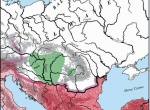 full resolution
full resolution
Fig. 1. Avar Khaganate in Central Europe around the year 600 AD; according to W. Pohl (1988, map 2), drawing I. Jordan. a – b – Byzantine Empire; c – conjectured extent of the Avar Khaganate; d – areas under Avar influence.
-
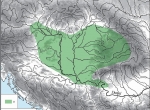 full resolution
full resolution
Fig. 2. Avar Khaganate w Central Europe around 700 AD; according to O. Heinrich-Tamáska (ed.), 2011, pp. 653-702, Pl. II. a – extent of Avar occupation.
-
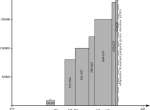 full resolution
full resolution
Fig. 3. Amount of tribute paid to the Avars by the Byzantine Empire; according to W. Pohl (1988, p. 501); drawing I. Jordan.
-
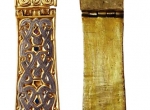 full resolution
full resolution
Fig. 4. Zamárdi-Rétiföldek, Hungary, grave no. 1280. Elaborate belt mount (7th c.) in the Animal Style (Tierstil II), a variant characteristic for the Avars; Kaposvár, Rippl Rónai Múzeum, 93.16.1; photo.: K. Balla.
-
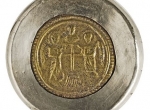 full resolution
full resolution
Fig. 5. Keszthely-Fenékpuszta, Hungary, Horreum, grave 14. Disc brooch with the image of the cross and Christ (over the cross) between two angels, early 7th c.; Balatoni Mus. Keszthely, 60.14.3; Photo. J. Bicskei.
-
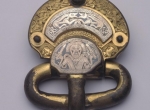 full resolution
full resolution
Fig. 6. Kölked-Feketekapu B, Hungary, grave no. B 85 (female burial). Belt buckle, gilded bronze decorated with niello. The figure at centre is presumably the Germanic god Tyr; according to A. Kiss, Das awarenzeitliche Gräberfeld in Kölked-Feketekapu B, Bu


